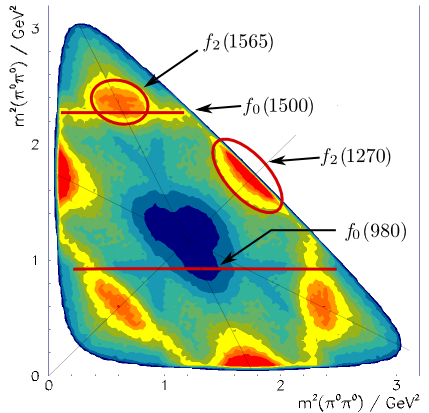 Search for Gluonic Excitations
Search for Gluonic Excitations
One of the main challenges of hadron physics is the search for gluonic excitations, i.e. hadrons in which the gluons can act as principal components. These gluonic hadrons fall into two main categories: glueballs, i.e. states where only gluons contribute to the overall quantum numbers, and hybrids, which consist of valence quarks and antiquarks as hadrons plus one or more excited gluons which contribute to the overall quantum numbers.
The additional degrees of freedom carried by gluons allow these hybrids and glueballs to have JPC exotic quantum numbers. In this case mixing effects with nearby qq states are excluded and this makes their experimental identification easier. The properties of glueballs and hybrids are determined by the long-distance features of QCD and their study will yield fundamental insight into the structure of the QCD vacuum. Antiproton-proton annihilations provide a very favourable environment to search for gluonic hadrons.
Charmonium Spectroscopy
The charmonium spectrum can be calculated within the framework of non-relativistic potential models, EFT and LQCD. All 8 charmonium states below open charm threshold are known, but the measurements of their parameters and decays is far from complete (e.g. width and decay modes of hc and ηc(2S)). Above threshold very little is known: on one hand the expected D- and F- wave states have not been identified (with the possible exception of the ψ(3770), mostly 3D1), on the other hand the nature of the recently discovered X, Y, Z states is not known.
At full luminosity PANDA will collect several thousand cc states per day. By means of fine scans it will be possible to measure masses with an accuracy of the order of 100 keV and widths to 10% or better. PANDA will explore the entire energy region below and above the open charm threshold, to find the missing D- and F- wave states and unravel the nature of the newly discovered X, Y, Z states.
D Meson Spectroscopy
The recent discoveries of new open charm mesons at the BaBar, Belle and CLEO has attracted much interest both in the theoretical and experimental community, since the new states do not fit well into the quark model predictions for heavy-light systems in contrast to the previously known D states. An important quantity which allows to distinguish between the possible different theoretical pictures is the decay width of these states (in particular the Ds states).
So far only experimental upper limits of a few MeV exist, limited by the detector resolution. Thanks to the excellent definition of the HESR antiproton beam PANDA will be able to measure these widths down to values of 100 keV by measuring the production cross sections close to threshold, which is sensitive to the resonance width.
Baryon Spectroscopy
An understanding of the baryon spectrum is one of the primary goals of non-perturbative QCD. In the nucleon sector, where most of the experimental information is available, the agreement with quark model predictions is astonishingly small, and the situation is even worse in the strange baryon sector. The PANDA experiment is well suited for a comprehensive baryon spectroscopy programme, in particular in the spectroscopy of (multi-)strange and possibly also charmed baryons.




